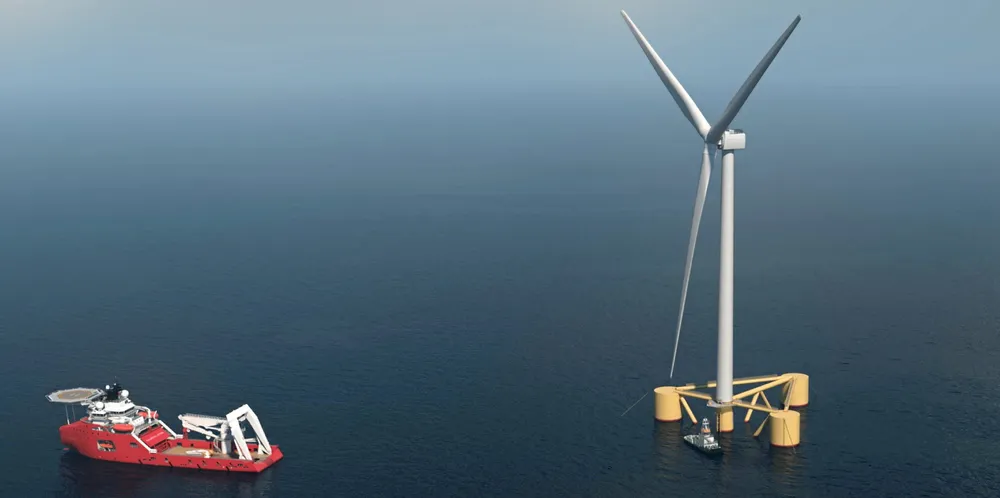Maritime giant NOV joins floating wind megaproject 'to halve' North Sea oil emissions
Cerulean Winds-led $14bn development would use 3GW deepwater turbine array to electrify oil & gas complexes while sending power to shore to run green hydrogen plant from 2024

A £10bn ($14bn) energy megaproject that could more than halve current greenhouse gas emissions from Britain’s offshore oil & gas operations by 2025 using a vast fleet of floating wind turbines linked to an onshore hydrogen plant has taken a lead-off step with developer Cerulean Winds naming its first ‘delivery partner’.
Green is the new black. Subscribe to Accelerate
Get the market insight you need into the global oil & gas industry's energy transition – from the new newsletter from Upstream and Recharge. Sign up here
“As the largest provider of marine equipment and wind vessel designs working in this space, the experience and knowledge they will bring to a project of this magnitude is second to none. Having them on board brings the scheme a step closer to reality,” said Cerulean co-founder Mark Dixon, a petroleum sector veteran who set up the company with oil industry colleague Dan Jackson.
“We have a number of Tier 1 delivery stakeholders signed up. They are some of the largest providers in the world, with the scale and capacity to deliver,” he added, with further contracts to be sealed “in the coming months”.
“The floater and the mooring systems together is the key piece of the project, but of course there is the hydrogen facility, the transmission cables, the installation work for the turbines and also the substations still to come.”
Planned for construction over two sites in the West of Shetland and in Central North Sea called ‘Aspen’ and ‘Beech’, the floating wind array will be based around steel semisubmersible platforms, given the designs “versatile” fieldwork over decades in the offshore oil & gas, and its suitability to fabrication and assembly in yards serving the North Sea,” said Dixon.
“We started the journey agnostic to the platform type but with a couple key criteria – and this is based on our knowledge from the deepwater oil & gas sector over the last 20 years: it had to be steel to meet local content requirements and it had to be a semisub because it is versatile structure and is well-proven design for any environment.”
'Oil industry expertise and experience'
Jackson adds: “The other criterion was that we have the backing of a Tier 1 marine contractor like NOV. This is very important because it goes to the decades of knowledge and scale of company that is coming to the table here.
“This is oil industry bringing expertise and experience to the wind industry. This is the clearest crossover of domain knowledge. And it needs to be given we will be building this project in one of the most hostile environments on the planet.”
Cerulean has submitted a formal request for seabed leases for the project to Marine Scotland but “timing involved in gaining approvals for the project is critical”, said Jackson, for the company to be able to reach financial close in Q1 2022 and have the project infrastructure built and then power ramping up between 2024-2026.
To this end, Cerulean has asked the Scottish and UK governments to make an “exceptional case to deliver an extraordinary outcome” in speeding the decarbonisation of one of the biggest offshore oil basins in the world.
“The [UK and Scottish] regulators across the board all understand the urgency that oil & gas operations are rapidly decarbonised. The mission is very clear: get rid of the oil & gas emissions as quickly as possible or we’ll miss the North Sea Transition Deal targets and all the other [climate] targets. And that would be a loss for everybody.”
'Staged' supply chain development
Dixon said: “The [Scottish] government will potentially co-invest, to help develop the infrastructure, to build this out, because with ScotWind following on they start to see there is that orderbook lining-up [for construction and servicing of the North Sea offshore wind industry] as we go forward.”
Scotland long-struggling former oil & gas fabrication yards will be engaged “in stages”, starting with component assembly of the floating platforms for the Cerulean project, and then developing the factories that will fabricate future units, said Dixon.
“The Scottish supply chain can certainly get itself to the point where the assembly work – and these are large jobs with massive steel columns and frames – is absolutely possible from the start of the project and potentially toward the end of the project, we are going to be rolling out 200 units remember, a good amount of the fabrication too,” said Dixon.
“This will provide the supply chain to get the investment they need to build out their facilities.”
Joe Rovig, president of NOV Rig Technologies, stated: “This ground-breaking proposal, which will leverage NOV’s core competencies as well as our UK and European infrastructure and personnel in a key energy transition project, will drive major progress in the goal of decarbonising the offshore UK sector.
“NOV is eager to demonstrate our abilities as one of the key partners and household names in the global energy transition, just as it has been for decades in the traditional oil & gas industry.”
Cerulean said it completed all infrastructure planning for the project “to ensure the required level of project readiness”.